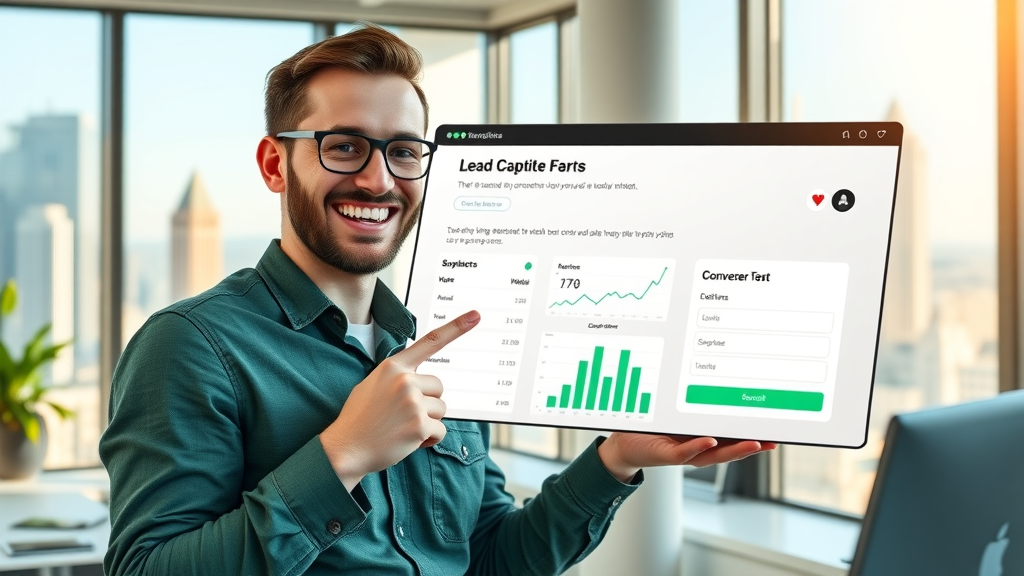Did you know that over 60% of marketers say lead generation online is their single biggest challenge? Yet, only 20% of landing pages actually turn website visitors into qualified leads . In today's digital-first world, relying on outdated lead gen tactics simply doesn't cut it. If you're struggling to consistently fill your sales funnel, this comprehensive guide will arm you with the latest strategies, actionable insights, and the best tools you can use—right now—to build a thriving pipeline and outpace your competitors.
Why Most Businesses Fail at Lead Generation Online: The Shocking Truth
- Over 60% of marketers cite lead generation online as their top challenge
- Only 20% of landing pages convert visitors into qualified leads
- Discover why traditional lead gen tactics no longer work and how you can gain an immediate advantage

Despite increasing investments in new marketing software and automation platforms, most organizations continue to see weak results from their online lead generation campaigns. This is often due to clinging to outdated tactics—think untargeted email blasts, generic landing pages, and overcomplicated lead capture forms that send potential customers running. High-performing companies are swapping out such strategies for data-driven, audience-first approaches, with a focus on smart automation, optimized sales funnels, and content that speaks directly to their target audience. If you want to close the gap and build a healthy sales pipeline, you must address the real issues holding your lead generation efforts back—from identifying qualified leads to unlocking the full potential of your landing pages and adopting modern lead gen tools.
What You'll Learn in This Guide
- Mastering lead generation online for sustainable business growth
- Choosing and optimizing lead gen tools and landing pages
- Building a sales funnel that nurtures, qualifies, and converts
- Outbound lead gen tactics vs. inbound strategies
- Using email marketing and social media effectively for lead capture
Understanding the Foundations of Lead Generation Online

Lead Gen Basics: Definitions and Core Concepts
- What is lead generation online?
- How does lead gen compare with traditional lead generation?
At its core, lead generation online means attracting potential customers (website visitors) and motivating them to share their contact info—making them sales prospects for your business. Unlike traditional lead gen methods like trade shows or direct mail, online lead gen leverages digital channels: your website, optimized landing pages, social media campaigns, and targeted ads. This shift allows businesses to reach a broader and more relevant audience, track interactions in real time, and scale efforts quickly through marketing automation. By focusing on digital lead capture, you can immediately respond to prospect inquiries, tailor your marketing campaigns to their behaviors, and nurture high-intent leads through custom content and offers. The modern approach to lead gen is less about quantity and more about quality—finding those individuals who are far more likely to become qualified leads and future loyal customers.
Types of Leads: Qualified Leads, Sales Leads, and More
| Lead Type | Description | Example |
|---|---|---|
| Information Qualified Lead (IQL) | Top-of-funnel, interested in your content | eBook sign-up |
| Marketing Qualified Lead (MQL) | Engaged and fits your buyer persona | Downloaded case study |
| Sales Qualified Lead (SQL) | Ready for outreach | Requested a demo |
Understanding lead types is crucial for designing an effective sales funnel. For example, an Information Qualified Lead (IQL) is a website visitor drawn in by content, while a Marketing Qualified Lead (MQL) shows deeper engagement, possibly by interacting with a landing page or subscribing to a newsletter. Finally, a Sales Qualified Lead (SQL) is someone ready for personal outreach from your sales team. Properly tracking and scoring each type allows your team to spend more time with the leads most likely to convert.
Establishing clear criteria for each lead type also makes it easier to align your lead generation tool with your overall marketing campaign. Tools that automate lead scoring and segmentation help you deliver the right content at the right time, increasing your conversion rate and building lasting customer relationships.
Key Elements of High-Converting Lead Generation Online Strategies
Building Effective Landing Pages for Lead Capture
- Essential landing page elements for online lead generation
- Optimizing lead capture forms for conversions
- Case studies: Top performing landing pages in lead generation

A high-converting landing page is the linchpin of any successful lead generation online campaign. It should feature a single clear call-to-action (CTA), concise headlines, and persuasive benefits. Keep navigation minimal to boost conversion rates by preventing users from wandering off. Integrating a strong offer—like a free download or product trial—serves as an irresistible motivation for lead capture.
Your form should only request essential contact info. Overly long forms can deter even the most interested potential customer. A/B testing different layouts, button colors, and copy can yield lift in conversions. Case studies show that landing pages which incorporate testimonials, simple forms, and clear value props can increase lead conversions by over 40%.
The best landing pages don’t just collect data—they build customer trust and seamlessly transition each website visitor into your sales funnel. Put real-world social proof, guarantees, and answers to common objections front and center for the fastest results.
Choosing the Right Lead Generation Tools
- Overview of best lead generator and lead generation tool options
- Evaluating generation tool features and integrations
Picking the right lead generation tool is critical for scaling your efforts. Look for solutions that integrate natively with your website, CRM, and marketing automation software. Popular options like HubSpot, Leadpages, Unbounce, Mailchimp, and ActiveCampaign provide robust templates for landing pages, advanced analytics, and built-in automation for lead follow-up.
When selecting a lead generator tool, evaluate whether it supports critical features such as dynamic content, multichannel capture (forms, pop-ups, chatbots), and contact scoring. Your chosen platform should also make it easy to segment leads and automate nurture sequences. Integration with sales and customer support platforms will further help your team close deals efficiently and ensure that no potential sales leads fall through the cracks.
Ultimately, the best generation tool matches both your industry’s needs and your sales process—ensuring every lead enters your pipeline at the right stage, with the right info, and primed for conversion.
Crafting Your Sales Funnel: From Website Visitor to Qualified Lead
- Mapping the full lead generation online journey
- Moving visitors through the sales funnel
- Using automation tools for scalable lead gen
Sales funnels guide a website visitor through awareness to conversion—and form the backbone of strategic lead generation online efforts. The best funnels are mapped from initial touchpoints (ads, blog posts, or social media) to landing page lead capture forms, follow-up emails, and ultimately, direct outreach by your sales team to the most qualified leads.
Begin by clearly mapping each touchpoint in your funnel and ensuring content and offers align with the needs of your target audience at each stage. Use automation tools to deliver personalized follow-ups based on how a prospect interacts with your landing page, downloads, or emails. Scalable lead generation online requires constant monitoring and optimization, so use analytics to refine every step and spot leaks.
Integrating your funnel with lead scoring systems ensures that your sales team can prioritize outreach to the most qualified leads quickly. Whether employing email marketing campaigns or outbound lead gen techniques, always track results to continually boost your conversion rates.
How to Generate High-Quality Leads Online: Step-by-Step Process

Step 1: Identifying and Targeting Your Audience
- Using marketing software and analytics to profile your target audience
- Personalizing your outreach for better lead gen
The foundation of lead generation online is understanding your target audience —their needs, pain points, interests, and buying behaviors. Modern marketing software, like CRMs or Google Analytics, provides actionable insights that help you build detailed personas of your ideal potential customers . Segment your audience by demographics, behavior, and interaction history to create relevant offers and optimized landing pages.
Personalization isn't just a buzzword—prospects are much more likely to provide their contact information when your offer speaks directly to their situation. Take advantage of dynamic content on landing pages, targeted email marketing sequences, and social media retargeting to reach your audience with tailored messages. This ensures every touchpoint in your marketing campaign moves the right website visitors closer to becoming qualified leads.
Leadership in modern lead gen comes from continuous learning. By using analytics to uncover which channels, offers, and copy resonate most, you can ensure ongoing improvements in your lead capture and nurture strategy.
Step 2: Outbound Lead Gen vs. Inbound Strategies
| Strategy | Description | Pros | Cons |
|---|---|---|---|
| Outbound Lead Gen | Proactive outreach (email, cold calls) | Quick results | Can be intrusive |
| Inbound Lead Generation | Content, SEO, social media | Builds trust | Slower process |
Deciding between outbound lead generation (cold emailing, calling) and inbound methods (content marketing, SEO, social media) is crucial. Outbound lead gen delivers faster but might alienate prospects if not personalized, while inbound strategies foster trust over time by providing valuable content that draws website visitors in naturally.
The best lead generation online frameworks typically blend these approaches. For instance, pairing a social media marketing campaign with personalized follow-up emails and retargeted ads on landing pages can maximize your conversion rate. Analyze results from each strategy within your marketing campaign to find the best mix for your industry, audience, and product or service.
Remember, the goal is to strike a balance—never relying too heavily on one channel or approach. Diversify to remain resilient and scalable as algorithms, audience tastes, and competitive tactics change.
Step 3: Designing Landing Pages that Convert
- Landing page layout tips for lead gen
- A/B testing landing pages for online lead generation
Your landing pages should be laser-focused: a single headline, a concise value proposition, a visual cue toward your lead capture form, and a compelling CTA. To boost the conversion rate, place contact fields above the scroll line, limit form questions, and use attention-grabbing buttons. Trust indicators—such as client logos, reviews, and certificates—will alleviate buyer hesitation and ensure higher conversion rates.
Run regular A/B tests on headlines, colors, images, and CTA copy. Use analytics tools to measure which combinations yield the highest lead gen results. Top online marketers consistently optimize landing pages based on data, refining layouts to increase both the volume and quality of qualified leads.
Don’t forget to optimize for mobile—over half of website visitors access your landing pages from smartphones. Fast load times and mobile-friendly form fields are must-haves for successful lead generation online.
Powerful Tools and Software for Lead Generation Online
Top Lead Generation Tools and Their Key Features

- Comparison of popular lead gen and marketing software
- Lead capture integrations for automation
Today’s best lead generation tools offer more than just form building. Platforms like HubSpot and ActiveCampaign provide automated email follow-up, advanced lead scoring, deep analytics, and CRM integrations. Leadpages and Unbounce focus on drag-and-drop landing page design, A/B testing, and one-click integration with email marketing and CRM tools. These features make it possible to seamlessly move qualified leads through your sales funnel and trigger relevant marketing campaigns.
Key integrations to look for include CRM sync, multi-step forms, embedded chatbots for instant lead capture, and real-time notifications for sales teams. Top generation tool choices automate a huge part of the process so your team can focus on engaging and converting rather than managing admin tasks. Automation provides scalability—the more your tool can do on autopilot, the more leads you can handle.
Additionally, check that your selected lead gen tool offers strong reporting, customizable dashboards, and robust support. These ensure you can quickly spot and fix leaks in your sales process and continuously improve your conversion rates and ROI.
The Best Lead Generation Tool for Your Needs
- Pros and cons of each lead generation tool
- Niche generation tool solutions for industry-specific lead gen
No single tool fits every organization’s needs. For SaaS and B2B, HubSpot offers powerful workflows and robust reporting, while Mailchimp is excellent for those prioritizing list building and automated email marketing. E-commerce businesses may prefer OptinMonster or Privy for their pop-up and cart abandonment features. Consider the complexity of your sales funnel, your budget, and the technical resources at your disposal.
The right solution will make it simple to set up new landing pages, segment audiences, score lead data, and automate campaigns. Look for specialty generation tool options—like industry-specific integrations for real estate, finance, healthcare, or education—for even more targeted lead capture and qualification.
Ultimately, testing a few tools and carefully reviewing how they integrate and support your full marketing campaign is key to choosing the best lead generation tool for your goals.
Supercharging Lead Generation Online with Email Marketing and Social Media
Maximizing Email Marketing for Online Lead Gen
- Building email lists from website visitors
- Crafting email sequences for lead nurturing
- Email capture techniques on landing pages

Email marketing remains one of the highest ROI channels for lead generation online. Begin by using landing page forms to collect emails from engaged website visitors—offer something valuable in exchange (like a guide, free trial, or exclusive discount). Upgrade your sign-up incentives regularly to keep your list growing with qualified leads .
Once you have their contact info, nurture leads with email sequences tailored to their interests. Automation platforms allow you to send welcome emails, product tips, case studies, and timely demos—without manual work. Use segmentation and behavioral triggers to refine your messages, ensuring each potential customer receives just what they need to take the next step. Embedding email capture forms throughout your site, using pop-ups, and adding gated content are proven ways to boost your list even faster.
Remember, relevant, timely content turns raw leads into sales-ready prospects and warms up your sales team’s pipeline for faster closes and healthier conversion rates.
Harnessing Social Media as a Lead Generator
- Using LinkedIn, Facebook, and Instagram for direct lead capture
- Proven social media campaigns for effective lead generation

Social media is a goldmine for lead generation online when platforms are used strategically. LinkedIn excels for B2B lead capture, empowering businesses to run targeted ads and sponsored messages to decision-makers. For B2C, Facebook and Instagram offer customizable lead forms, retargeting, and native integration with landing pages. Select social platforms where your ideal target audience spends the most time and launch campaigns specifically designed for direct lead gen—like contests, gated content, or webinar registrations. A/B test post types, formats, and CTAs just as you would with landing pages. Use ad analytics and tracking pixels to follow website visitors across social channels and your website, then re-engage them with tailored follow-ups.
The most successful social media lead generation efforts combine organic reach (community-building, viral posts) with paid strategies to accelerate scale. Whether you manage it in-house or partner with a social agency, integrating social with your landing page and email marketing campaigns will maximize your qualified leads.
Make every interaction count—consistently respond, offer value, and use social listening to understand and speak to your potential customers’ needs throughout your sales funnel.
Optimizing and Tracking Your Lead Generation Online Performance
Measuring Online Lead Generation Success Metrics
| Metric | Purpose | How to Optimize |
|---|---|---|
| Conversion Rate | Measures landing page effectiveness | Test CTAs & forms |
| Cost Per Lead | ROI of ad spend | Refine targeting |
| Lead Quality | Sales-ready vs. non-ready leads | Score and prioritize |
Tracking your conversion rate , cost per lead, and lead quality allows you to measure the health of your lead generation online campaigns and optimize your efforts for maximum ROI. Reviewing landing page analytics highlights which offers or forms convert best, while monitoring CPL (cost per lead) helps you allocate ad budgets efficiently. Lead scoring—ranking leads by engagement, fit, and intent—lets your sales team prioritize outreach to those most likely to close. Use marketing software to visualize funnel performance, identify drop-off points, and score leads automatically based on behavioral data.
Regular metric reviews reveal your fastest paths to more qualified leads, letting you double down on what works and quickly phase out underperforming tactics or channels. Remember, the deeper you track, the better you can optimize every phase of your sales funnel.
Improving Performance with A/B Testing and Analytics
- Key elements to test in landing pages and lead capture forms
- Using analytics tools to improve the sales funnel

The most successful lead generation online strategies are driven by experimentation and data. Use A/B tests to refine everything from landing page headlines and form fields to email subject lines and CTA button colors. Even a small tweak can have an outsized impact on conversion rates.
Leverage modern analytics tools (like Google Analytics, Hotjar, or built-in CRM dashboards) to track user behavior and pinpoint where website visitors bounce or exit. Map your sales funnel and flag any friction points—such as confusing forms, slow load times, or poorly targeted content.
Regularly review campaign performance and reallocate budget to top-performing channels. Analytics don’t just identify problems; they reveal new opportunities for growth and innovation, keeping your lead generation pipeline full and efficient.
Common Pitfalls in Lead Generation Online and How to Avoid Them
Mistakes to Avoid with Lead Gen Tools and Landing Pages
- Overcomplicated forms deter conversions
- Ignoring follow-up processes in the sales funnel
- Overreliance on outdated outbound lead strategies

Simple mistakes can sabotage months of hard work. Overly complex lead capture forms—requesting more than necessary contact information, for instance—will decimate conversion rates, especially with mobile users. Similarly, failing to nurture new leads after capture results in lost opportunities and wasted ad spend.
Clinging to outdated outbound lead gen methods, like cold calls without personalization or value, often alienates modern buyers already buried in unsolicited calls and emails. Instead, blend inbound with targeted outbound for timely, relevant engagement.
Always audit your marketing software integrations, landing page load times, and follow-up processes. Periodically review your own website as if you’re a customer—if you wouldn’t submit your info or feel valued after a sign-up, it's time to optimize.
Keeping Lead Generation Ethical and Compliant
- Email marketing compliance (GDPR, CAN-SPAM)
- Quality over quantity: Why qualified leads matter most
Ethical lead generation online starts with respecting privacy and following laws like GDPR and CAN-SPAM. Always get consent before emailing prospects, clearly disclose how their info will be used, and allow easy opt-outs. Noncompliance damages your reputation and can lead to legal penalties.
More importantly, focus on quality over quantity . A smaller list of qualified leads —interested, engaged, and a fit for your product or service—will always outperform massive lists of unqualified contacts. Respect your audience’s time, deliver value in every marketing campaign, and prioritize relationship-building over spamming.
"A successful lead generation online strategy isn’t just about numbers—it’s about reaching the right audience with the right message at the right time."
Real-World Examples: Lead Generation Online Success Stories

Landing Pages that Deliver Impressive Results
- Case studies: How Company X increased qualified leads by 40%
- Step-by-step breakdown: Optimizing landing pages for lead gen
Take Company X: After identifying high bounce rates on its homepage, the marketing team reworked their landing page layout, using concise headlines, testimonial-driven social proof, and a simple lead capture form. They split-tested several value propositions and streamlined their mobile experience. The results? A 40% uptick in qualified leads and a 28% reduction in cost per lead in just three months.
The secret was constant A/B testing, using customer feedback to shape offers, and aligning the look and content of their landing pages with buyers' expectations at every funnel stage. This blueprint is repeatable, no matter your industry.
Transforming Website Visitors into Qualified Leads
- Mapping the customer journey
- Lead capturing techniques that work
One e-commerce retailer mapped every step of its website visitor journey—from paid ad click, to product education page, to landing page, to email sign-up, and finally to purchase. By crafting targeted pop-ups for different audience segments and using progressive lead capture forms, they doubled their sales pipeline in six months.
The key: Understanding audience intent and meeting prospects with the right message via smartly placed CTAs and ongoing nurture campaigns. Monitor every interaction and be ready to tweak offers, layout, or copy, ensuring you never lose out on potential customers.
People Also Ask
How to do online lead generation?
- Identify your target audience
- Create value-driven landing pages
- Utilize email marketing and social media tools
- Deploy lead generation tool solutions
- Nurture leads within your sales funnel.
Can ChatGPT do lead generation?
- Yes, ChatGPT can automate initial outreach, qualify leads through conversational scripts, and support lead capture on landing pages or websites via chatbot integrations.
How to generate leads remotely?
- Use digital advertising for landing pages
- Employ virtual events/webinars for lead capture
- Leverage marketing software for remote outreach and lead tracking
How much should you pay for lead generation?
- Lead generation costs vary by channel and quality: typically from $10 to $200 per qualified lead depending on industry, sales funnel complexity, and lead gen tool investments.
Pro Tips and Best Practices for Sustainable Lead Generation Online
- Focus on audience-driven content for qualified lead generation
- Streamline landing page design for faster lead capture
- Integrate lead generator tools with CRM and marketing software
- Continually test and optimize your sales funnel
- Use multiple channels (email marketing, outbound lead gen, and social media) for best results
Frequently Asked Questions about Lead Generation Online
- What is the difference between a lead and a qualified lead? A lead is anyone who shows initial interest by providing contact information, while a qualified lead meets additional criteria—like budget, authority, or need—making them much more likely to buy. Lead scoring and targeted follow-up can help you focus on the best prospects.
- Which is better for lead generation online: inbound or outbound lead gen? Both have value. Inbound builds trust and authority, while outbound delivers fast results. The best strategies blend content marketing, social media, and personalized outreach for optimal lead gen.
- How long does it take to see results from lead generation tools? Results can often be seen within 30-90 days with consistent effort, optimized landing pages, robust follow-up, and ongoing A/B testing, but it depends on industry, offer, and traffic levels.
- What are the must-have elements of a landing page for online lead generation? Every landing page should have a compelling headline, concise copy, a prominent lead capture form, clear CTA, trust signals, and be mobile optimized for the highest conversion rates.
Expert Insights: Quotes from Industry Leaders
"Effective lead generation online isn’t about quantity—it’s about targeting your message and capturing only the leads that matter." – Jane Smith, Digital Marketing Expert
"The right combination of landing pages, social media, and smart automation turns website visitors into your best sales leads." – John Doe, SaaS Growth Advisor
Checklist: Essential Lead Generation Online Steps
- Define your target audience for lead gen
- Create optimized landing pages for lead capture
- Select and integrate the best generation tool
- Build a referral and lead nurturing system
- Measure, analyze, and iterate using marketing software
Key Takeaways for Successful Lead Generation Online
- Data-driven targeting enhances qualified leads
- Landing pages and sales funnels are conversion engines
- Diversify lead generation tools and strategies
- Consistent optimization ensures scalable lead generation online
Your Path Forward with Lead Generation Online
- Evaluate your current lead gen strategies
- Implement the tools and best practices shared in this guide
- Test, measure, and evolve your lead generation online processes for maximum ROI.
Explore Video: Top 5 Lead Generation Online Tools for 2024
- Demonstration and reviews of popular lead generation tools
- Tips for integrating landing page builders and marketing software
Video: How to Optimize Your Landing Page for Lead Capture
- Watch step-by-step landing page optimization using A/B testing
- Real-time walkthrough of lead capture improvements
Conclusion
Start applying these lead generation online strategies today—refine your target audience, optimize your landing pages, and integrate powerful generation tools to transform more visitors into loyal, qualified leads. Measure everything, evolve constantly, and you'll supercharge your sales pipeline for sustainable success!
 Add Row
Add Row  Add
Add 




Write A Comment